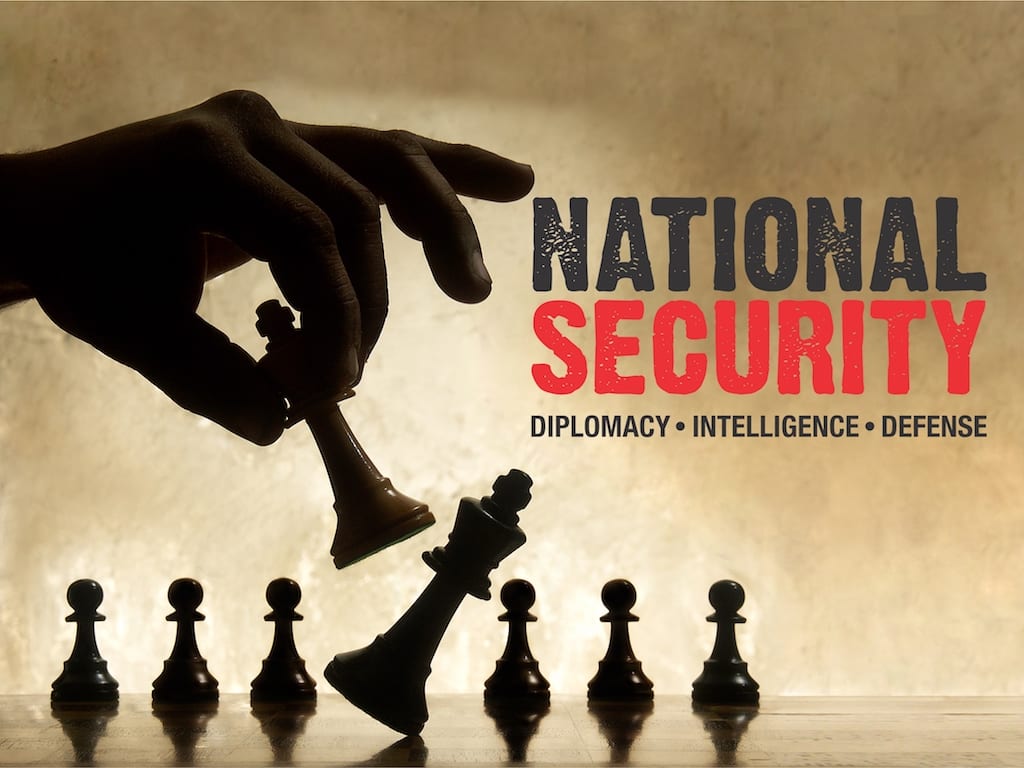
National Security
Do you know what it takes to keep an entire nation safe? It not only requires knowledge of how to handle disasters, but it also demands a cool head and tremendous leadership abilities. Learn about the critical elements of the job, such as evaluating satellite information, analyzing training procedures, assessing military engagement, preparing intelligence reports, coordinating information with other security agencies, and applying appropriate actions to various threats. Discover the requirements of our nation’s most demanding career.
Units at a Glance
Unit 1: Anatomy of National Security
Throughout recent decades, there has been a shift in America from a culture where terms like “national security” were not well known to a country so concerned with security that political campaigns are now won and lost based on border defense strategies. We’ll trace the development of national security in the United States, from the beginning of an idea to the thriving and huge Department of Homeland Security. You’ll learn the ins and outs of U.S. homeland security strategy, understand the agencies that oversee the response we have come to expect during disasters and emergencies, and identify the attitudes that drive the theories surrounding one of the most important issues of our time.
What will you learn in this unit?
- Explain the evolution of national security from World War II to the present day.
- Identify what the term “national security” means and its specific areas of concern.
- Trace the structural changes within our national government that have occurred as a result of the development of national security strategy.
- Explain how the Department of Homeland Security oversees the national security system and the major agencies involved.
Unit 2: Rules of Engagement in the National Security World
Learning how to deal with disagreements is one of the most important parts of learning how to be a person living in the world. Not all people agree with you or share your beliefs or even think they need to obey the law. The world is no different. Imagine how complicated it is to maintain peace among more than 190 countries, and you can better understand the struggle of maintaining international security. One of the most important parts of a healthy international security policy is the relationships we develop and maintain with other countries. It is therefore crucial to learn about international organizations and rules that govern keeping borders and countries secure, how the world navigates complicated issues to keep the peace, the rules of engagement that control the way nations fight when other options fail, and how the United States works within those limits.
What will you learn in this unit?
- Identify and explain the purpose of treaties and defense treaties in which the United States is currently involved.
- Understand the history of the United Nations and its role in international security.
- Explain the role of the UN Security Council, including its powers and strategies.
- Discuss the International Criminal Court, the four international crimes it investigates, and examples of these situations.
- Evaluate the rules of engagement, as well as their importance, and apply them to real-life scenarios.
Unit 3: The Ethics of National Security
Nothing about life is simple, and national security is certainly no exception. While international law and constitutional protections seem clear cut, they are much less easily applied when safety and security are at stake. Since the terrorist attacks on September 11, 2001, three areas have demonstrated how complicated it is to ethically apply laws and national security policies in the United States: the detainment of potential terrorists at Guantanamo Bay, the methods used by the government to interrogate those suspects, and the way the government gathered and used private communications to screen for potential terrorists. In this unit, you’ll get the opportunity to decide whether laws and protections have been applied fairly and ethically to issues such as interrogation procedures and detention for potential terrorists, as well as privacy in communication for citizens and non-citizens alike.
What will you learn in this unit?
- Understand how international law and constitutional rights apply to national security issues.
- Explain the ethical challenges surrounding issues of detention, specifically those related to habeas corpus.
- Describe how treatment of detainees during interrogation challenge international law, specifically the Geneva Convention.
- Understand the connection between privacy law and the Patriot Act, as well as the role of Edward Snowden.
- Argue whether the United States behaved ethically in its pursuit of national security.
Unit 4: Intelligent Intelligence
Information is power. This old adage is especially true in regard to the national security world, where, ideally, the right information can prevent disaster from occurring. Get ready for your own intelligence briefing as we explore what intelligence is and how it is collected, learn the difference between SIGNINT and HUMINT, and discover how organizations such as the Central Intelligence Agency (CIA), the Federal Bureau of Investigation (FBI), and the National Security Agency (NSA), among others, work every day behind the scenes to keep America safe.
What will you learn in this unit?
- Explain several different types of intelligence and how they are collected.
- Understand how cryptography, satellites, and drones contribute to the intelligence-gathering process.
- Describe the types of agencies working behind the scenes gathering intelligence and how they operate.
- Identify a few types of careers in the intelligence community and their responsibilities.
Unit 5: Natural Disasters and Security
When do you feel most confident and safe? If you think about it, it’s likely when the rest of your world is stable. It’s hard to handle something challenging, or to feel secure enough to do something daring, when the most basic elements of your life have been upended. The same is true for nearly everyone, and natural disasters can quickly throw everything you know into upheaval. An essential part of the United States’ national security strategy is to quickly respond to those disasters and to restore essential systems and services so that life can continue as it once did. Understanding how that process works helps put into perspective how all of the parts of a national security strategy work together to create a safe, stable country.
What will you learn in this unit?
- Identify why national disasters threaten the security of any country.
- Describe the two primary agencies for addressing natural disasters.
- Explain how Hurricane Katrina demonstrated flaws in the disaster response system, and how it resulted in change.
- Understand how the disaster response system works among local, state, and national authorities and the role that the Federal Emergency Management Agency (FEMA) plays.
- Recognize how the Centers for Disease Control and Prevention (CDC) works to prevent and address outbreaks of diseases in order to prevent a widespread issue.
Unit 6: Human-Made Disasters and National Security
We’ve seen what natural disasters can do, bringing a powerful punch to populations that are often unprepared for their fury and intensity. But when you think of disasters, do you also think about those caused by people? In 2015, of the 353 catastrophic events worldwide, 155 of them were the result of human activity. Some of the most powerful threats to the United States come not from the weather but from people. Human-made disasters, whether environmental, industrial, or humanitarian, can have the same devastating power to destroy lives and communities that massive storms or wildfires have. To keep a community safe, a national security strategy must include a way to prepare for, and ideally prevent, the human-made events that can harm families, cities, and even nations.
What will you learn in this unit?
- Identify the types of environmental disasters that are the result of human error or bad intention.
- Discuss the industrial accidents and potential hazards that pose a threat to national security.
- Examine the humanitarian crises that can affect the nation.
- Explain how U.S. government agencies work to respond to and prevent human-made disasters.
- Analyze at least one event from each type of human-made disaster to understand potential national security threats.
Unit 7: Terrorism and National Security
According to Federal Bureau of Investigation (FBI) officials, the United States is at the greatest threat level from terrorist groups since September 11, 2001. No doubt, the way we live, work, play, and think about national security changed when four planes were hijacked and crashed into the World Trade Center, the Pentagon, and a field in Pennsylvania. But now, more than 15 years later, what does a national security strategy against terrorism look like? What does it entail, and is a single-minded focus on groups like al-Qaeda and ISIS effective?
What will you learn in this unit?
- Identify how key changes in policy and agency procedure address the threats of terrorism brought to light by 9/11.
- Define international and domestic terrorism.
- Understand the difference between a lone wolf/homegrown terrorist and a jihadist in relationship to recent attacks.
- Discuss the different types of terrorist threats and the agencies in charge of protecting against those threats.
- Explain how terrorism has changed since 9/11 and the challenges that poses to anti-terrorism efforts.
Unit 8: Predicting and Preparing for the Future
Simply buying a car doesn’t make you a good driver and neither does deciding when and where you’ll drive. Mapping out your route, putting in enough gas, even checking the oil and fluids are all a part of the process, but they don’t work independently of one another to make the trip a safe and pleasant one. What does? Getting out on the road and practicing your skills. The same is true of any national security strategy and the agencies that work to implement those strategies. While some agencies may have the opportunity to practice their skills on a daily basis as they intercept intelligence, keep borders safe, screen passengers and luggage, and gather leads for investigations, other agencies are not offered that opportunity until the worst-case scenario happens. To create a safe, secure nation, those involved in the process not only need a clear plan but also require the opportunity to practice those plans together so that when the time comes to implement them, everyone is ready.
What will you learn in this unit?
- Recognize the types of threats that the national security community works to prevent and respond to.
- Explain the purpose of the National Incident Management System and the National Response
- Framework, including the five areas of response.
- Understand the merits of an all-hazards plan and a whole-community approach to preparedness.
- Identify the core capabilities that make up a response and preparation plan.
- Analyze potential response scenarios and how agencies practice their responses.
Required Materials
Software
- Word processing software



